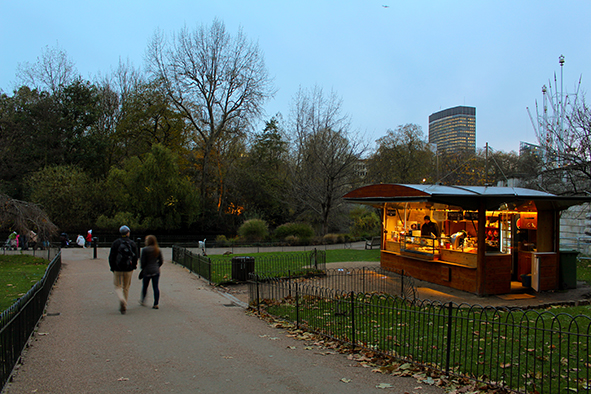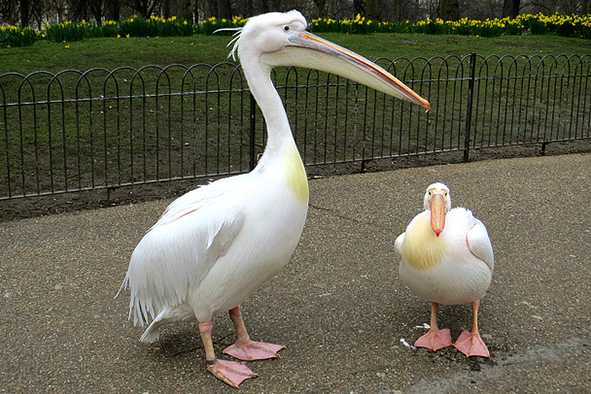One of the most popular public parks in the world pays homage in more ways than one to the former British Empire.

St. James’s Park cafe (Photo: Paul Stafford)
Two small siblings advanced on a gaggle of unsuspecting Canada Geese with a slice of white bread. The languorous birds looked quizzically at the two elated humans approaching them in brightly coloured coats, before one noticed the bread. It honked a signal and before long the children were surrounded by avian hunger; the bread lost in a flurry of furious pecking.
The parents whisked their progeny to safety, laughing at the stunned expressions on their faces. If they had been in St. James’s Park 400 years ago however, geese would have been the least of their worries.
One of the most popular city parks in the world, visitors to St. James’s perhaps do not realise quite how much of an ode to British imperialism it truly is.
Park Life
In 1531 St. James’s Park was given its first function to humanity when King Henry VIII had the marshy land drained to accompany the construction of St. James’s Palace – the primary royal residence for 300 years until Queen Victoria moved across the street to Buckingham Palace in 1837. Deer were raised in the park for hunting in nearby Hyde Park. Nowadays the wily fox and the industrious grey squirrel are the largest native mammals.
Statues to commemorate the great Britons who took land from others to give to the crown are dotted all around. Bookending Pall Mall are Nelson’s Column – the centrepiece of Trafalgar Square – and the Victoria Memorial outside Buckingham Palace.
Other notable figures in the expansion of the Empire who reside in St. James’s Park in effigy include Captain James Cook and, off to one side of Pall Mall atop his own lofty column, the grand old Duke of York looks out over the tree tops of St. James’s. One theory postulates that he is set up so high to avoid the debt collectors who dogged his final years.
For over a century the park remained private land until the English Civil Wars brought an end to absolute monarchy. Even then it was not until the death of Oliver Cromwell and the restoration of the Monarchy through Charles II that the park was opened to the public. He redesigned the park to be more like a garden, adopting a layout that largely remains today, with the Mall and the lake running parallel.
Whatever your stance on hegemony there is no shortage of salacious history attached to the park. If plane trees could talk they would probably sound like the office gossip. Charles II was known to frequent St. James’s Park regularly with his favourite paramour (one of many), actress Nell Gwynn. One of London’s most famous documenters of the time, Samuel Pepys would, on occasion, join them, referring to Miss Gwynn as ‘pretty, witty Nell’.
Magnificent Beasts
By the time they were ambling along the Mall, which today is beset by a steady flow of traffic, Britain’s attentions had begun to stretch beyond the confines of Europe. Exotic creatures quickly became a symbol of this march to global dominance. Perhaps best known of these are the pelicans, which were originally donated to Charles II by the Russian Ambassador in 1664 and have established themselves. Russia, like Britain had begun to colonise the world at the time, but they were still 150 years away from the Great Game that would pit the two bloated empires against one another in Asia during the Victorian era.
Other magnificent beasts that resided in St. James’s during the 17th Century that have no surviving ancestors included an elephant, camels and two crocodiles, which would have certainly produced a different outcome for the siblings with the bread whom I had witnessed.
St. James’s did in fact become an increasingly dangerous place, but not because of its menagerie. Wandering at dusk past thickets of Tibetan Cherry and Black Mulberry – a failed attempt by James I to establish a British silk industry – I felt completely safe. For various reasons St. James’s Park is now heavily policed.
Towards the end of the 17th and into the 18th Century, however, St. James’s spiralled into decline. Neglect and the pressures of rapid urbanisation in the industrial epoch did not come without their social drawbacks. Prostitution, drug use and all manner of dissolute activity would take place in St. James’s Park. One would be mad to walk through often even in the daytime, let alone after hours.
John Wilmot, 2nd Earl of Rochester, the depraved aristocrat immortalised in Stephen Jeffreys’ play ‘The Libertine’, wrote a poem entitled ‘A Ramble in St. James’s Park’, in which he declares of the park:
“Poor pensive lover, in this place
Would frig upon his mother’s face;
Whence rows of mandrakes tall did rise
Whose lewd tops f**ked the very skies.”
Much of that activity seems reserved now for the British high street on a Friday night rather than the royal parks.
As I walked past Duck Island there was a distinct calm. I shared the park with affable tourists who were taking an interest in the quaint cottage belonging to the Royal Ornithological Society. Two pretty American girls were attempting to take a selfie with the London Eye reflected in the water behind them.
Royal Obsession
Despite the modern security net being cast wide, there are still some holes in it. I ambled to the end of the pond closest to Buckingham Palace. Yellow and orange lights cast an eerie sallowness through the winter trees of West Island. It was here that the body of US citizen Robert James Moore was discovered in 2011.
A severe case of de Clérambault’s Syndrome meant that Moore had become obsessed with Queen Elizabeth II, our incumbent monarch. He took up residence on the island unbeknownst to authorities and, in an alcoholic stupor, presumably perished there some time in 2008.
With the Empire long gone and the royal family perhaps considered by the outside world as celebrities more than statespeople, it seemed an odd twist to the park’s ode to the Empire that the modern symbols of it, much like the pelicans (but thankfully for the children who like to feed geese, not like the crocodiles), were no longer associated with war and dominance but of lonely madness on a tiny, cold island.



